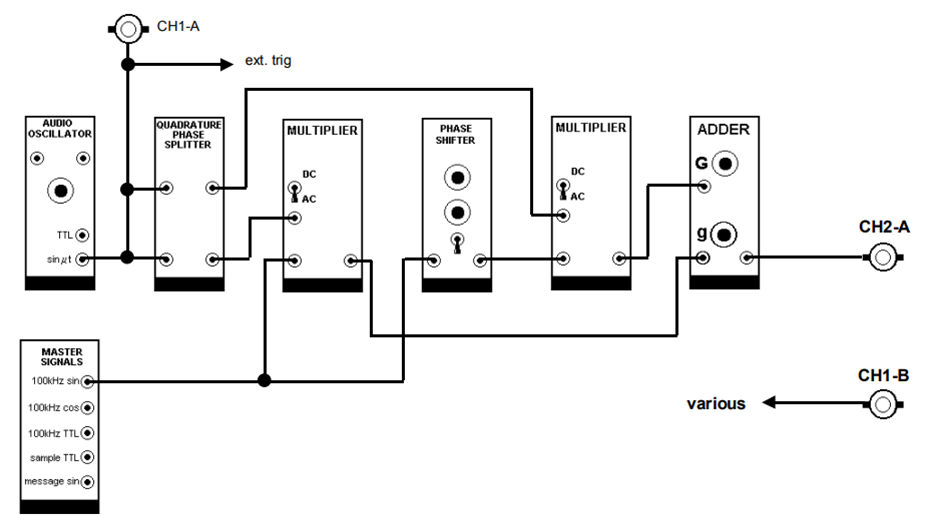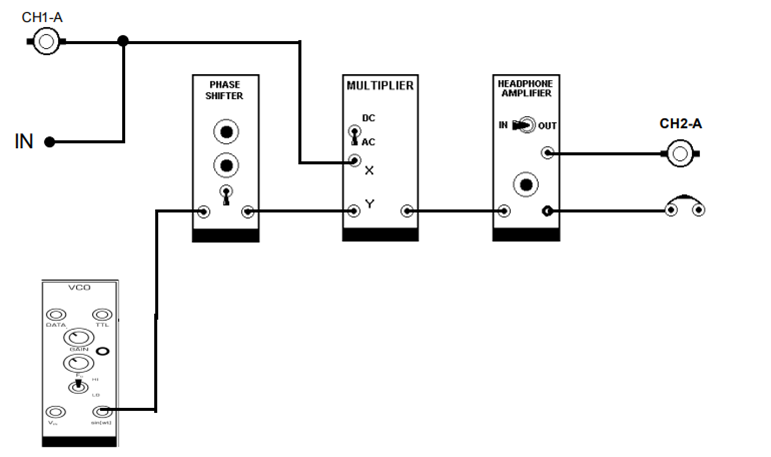SSB-SC Modulation
Theory
The SSB-SC modulated signal \( S(t) \) can be expressed as:
\( S(t) = \frac{A_c}{2} \left[ m(t) \cos(2\pi f_c t) \pm \hat{m}(t) \sin(2\pi f_c t) \right] \)
Where:
- \( A_c \) is the amplitude of the carrier signal.
- \( m(t) \) is the baseband (modulating) signal.
- \( f_c \) is the frequency of the carrier signal.
- \( \hat{m}(t) \) is the Hilbert transform of the modulating signal \( m(t) \).
In SSB-SC modulation, either the upper sideband (USB) or the lower sideband (LSB) is transmitted by choosing the corresponding sign (plus or minus) in the equation. The carrier \( A_c \cos(2\pi f_c t) \) is suppressed, and only one sideband is transmitted. This reduces the bandwidth required for transmission to half that of DSB-SC.
Block Diagram

Figure 1
Procedures :
1. Before patching up an SSB
phasing generator system, first examine the performance of the
QUADRATURE PHASE SPLITTER module. With the oscilloscope adjusted to
give equal gain in each channel it should show a circle. This will
give a quick confirmation that there is a phase difference of
approximately 90 degrees between the two output sine waves at the
measurement frequency. Phase or amplitude errors should be too small
for this to degenerate visibly into an ellipse. For the input signal
source use an AUDIO OSCILLATOR module. For correct QPS operation the
display should be an approximate circle. We will not attempt to
measure phase error from this display
2. Vary the frequency of the
AUDIO OSCILLATOR, and check that the approximate circle is
maintained over at least the speech range of frequencies.
3. When satisfied that the QPS
is operating satisfactorily, you are now ready to model the SSB
generator. Patch up a model of the phasing SSB generator, following
the arrangement illustrated in Figure above. Remember to set the
on-board switch of the PHASE SHIFTER (perform 180 degree phase
shift) to the ‘HI’ (indicates ‘high frequency range’) (100 kHz)
range before plugging it in.
4.
Set the AUDIO OSCILLATOR to about 1 kHz.
5. Switch the oscilloscope sweep
to ‘auto’ mode, and connect the ‘ext trig’ to an output from the
AUDIO OSCILLATOR. It is now synchronized to the message.
6. Display one or two periods of
the message on the upper channel CH1-A of the oscilloscope for
reference purposes. Note that this signal is used for external
triggering of the oscilloscope. This will maintain a stationary
envelope while balancing takes place. Make sure you appreciate the
convenience of this mode of triggering. Separate DSBSC signals
should already exist at the output of each MULTIPLIER. These need to
be of equal amplitudes at the output of the ADDER. You will set this
up, at first approximately and independently, then jointly and with
precision, to achieve the required output result.
7. Check that out of each
MULTIPLIER there is a DSBSC signal.
8. Turn the ADDER gain ‘G’ fully
anti-clockwise. Adjust the magnitude of the other DSBSC, ‘g’, viewed
at the ADDER output on CH2-A, to about 4 volts peak-to-peak. Line it
up to be coincident with two convenient horizontal lines on the
oscilloscope graticule (say 4 cm apart).
9. Remove the ‘g’ input patch
cord from the ADDER. Adjust the ‘G’ input to give approximately 4
volts peak-to-peak at the ADDER output, using the same two graticule
lines as for the previous adjustment
10. Replace the ‘g’ input patch
cord to the ADDER. The two DSBSC are now appearing simultaneously at
the ADDER output. Now use the same techniques as were used for
balancing in the experiment entitled Modelling an equation in this
Volume. Choose one of the ADDER gain controls (‘g’ or ‘G’) for the
amplitude adjustment, and the PHASE SHIFTER for the carrier phase
adjustment.
11. Balance the SSB generator so
as to minimize the envelope amplitude. During the process it may be
necessary to increase the oscilloscope sensitivity as appropriate,
and to shift the display vertically so that the envelope remains on
the screen.
12. When the best balance has
been achieved, record results. Although you need the magnitudes P
and Q, it is more accurate to measure (P and Q are Vmax and Vmin of
the SSB-SC modulated signal)
a) 2P directly, which is the peak-to-peak of the SSB
b) Q indirectly, by measuring (P-Q), which is the peak-to-peak of
the envelope.
13. As already stated, the TIMS
QPS is not a precision device, and a sideband suppression of better
than 26 dB is unlikely. You will not achieve a perfectly flat
envelope. But its amplitude may be small or comparable with respect
to the noise floor of the TIMS system. The presence of a residual
envelope can be due to any one or more of:
• leakage of a component at carrier frequency (a fault of one or
other MULTIPLIER )
• incomplete cancellation of the unwanted sideband due to
imperfections of the QPS .
• Distortion components generated by the MULTIPLIER modules.
Any of the above will give an envelope ripple period comparable with
the period of the message, rather than that of the carrier. Do you
agree with this statement? If the envelope shape is sinusoidal, and
the frequency is:
• Twice that of the message, then the largest unwanted component
is due to incomplete cancellation of the unwanted sideband.
• The same as the message, then the largest unwanted component is
at carrier frequency (‘carrier leak’)
SSB-SC Demodulation
Block Diagram

Figure 1
Procedures :
1. This is an asynchronous
demodulation process. Here frequency of the VCO is adjusted with the
frequency counter.
2. It is quite easy to make small
frequency adjustments (fractions of a Hertz) by connecting a small
negative DC voltage into the VCO Vin input, and tuning with the GAIN
control.
3. Here, VCO facilitates fine
tuning. Even if the frequency difference between the original
carrier frequency (e.g., 100 KHz) and the frequency of the VCO
differs by 10 Hz, then demodulated signal / speech will be quite
intelligible
4. A recommended method of
showing the small frequency difference between the VCO and the 100
kHz reference is to display each on separate oscilloscope traces -
the speed of drift between the two gives an immediate and easily
recognised indication of the frequency difference.
5. Connect an SSB signal, derived
from speech, to the input ‘X’ of the multiplier as shown in the
figure 1. Tune the VCO slowly around the 100 kHz region, and listen.
Report results.
